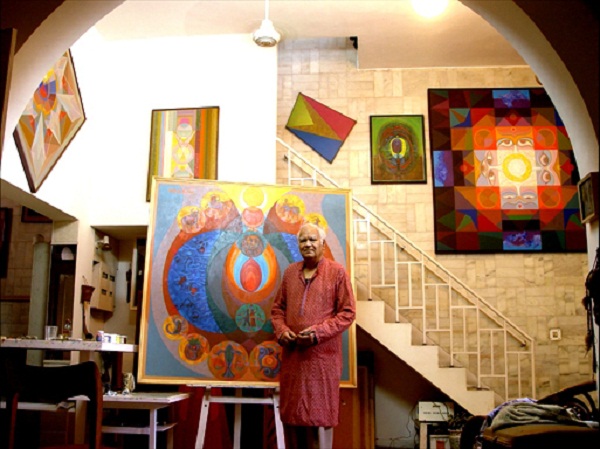
To create sublime art, one must live in the abstract.
Artist
For over sixty years, Om Prakash has been creating complex, abstract paintings drawn from both the timeless visual culture of Indian imagery and developments in modern art. His oeuvre includes approximately 2,500 luminous artworks focused on the relationship of mind, nature, spirit, and the inner universe.
Om Prakash was born December 14, 1932, in Bawal, Haryana, India, a “backward and benighted village town on the border of Rajasthan desert. [His] poor and conservative Brahmin family had no trace of interest in the creative arts.” However, even as a young boy, Om Prakash was impelled to create paintings for different religious festivals on the walls of his home. He has never stopped painting, and continues to do so daily in his New Delhi studio.
He witnessed India gaining independence in 1947. Pt. Jawahar Lal Nehru, the visionary leader and the first prime Minister of India, took the initiative to set up academies and institutions to promote arts and interaction among creative artists despite having many other demanding matters of governance. Under cultural agreements signed with most countries, several Indian artists went abroad and regularly exhibited their work. At the same time, many exhibitions, cultural programs, and artists from abroad were invited to India to share their work and give presentations. Thus, Indian arts and artists like Om Prakash were exposed to contact and influence from all over the world.
Explorer
Om Prakash has traveled throughout Asia, Europe and North America, voraciously seeking and studying ancient art and civilization’s great masterpieces. He has explored the United States, England, France, Germany, Finland, Austria, Italy, Greece, Egypt, Poland, Hungary, Belgium, Bulgaria, Russia, Latvia, Kazakhstan, China, South Korea, Japan, Singapore, Bhutan, Mauritius, Mongolia and Czech Republic.
After a successful exhibition at Kumar Gallery, New Delhi, he received a Fulbright Scholarship to attend Columbia University and the Art Students League in New York City, where he became friends with Mark Rothko, Robert Motherwell, Jasper Johns, Phillip Guston, and John Cage, amongst others. Later, in 1985, Prakash was one of eight artists selected by the late California artist Lee Mullican for the exhibition Neo-Tantra: Contemporary Indian Painting, Inspired by Tradition, presented at the UCLA Galleries in Los Angeles.
He participated in the vital conversation regarding the various directions of abstract art in the mid-twentieth century. He recalls an illuminating dialog with Mark Rothko:
“He looked at my paintings and said that he dug my freedom of doing what I wanted, while he was confined to work within his own formulations. He elaborated and told me that he felt like a prisoner surrounded by the high walls which were erected by himself. I said that I greatly admired him because he had found a way to express everything he wanted to, by formerly reducing his images to a rectangle – the least symbolically loaded form. I aspired then, to explore the capacities of a medium by taking it to its very extreme.”
Ultimately, Om Prakash seeks the spiritual in his work. While he references classical Indian imagery, he also moves beyond it. He and his Indian contemporaries, along with Western “Modern” artists, “opened new horizons and demolished the established norm that only religious subjects could make spiritual art.” In other words, “To create sublime art, one has to live in the abstract.”
Om Prakash has proven himself to be deeply committed to a pure visual language that conveys his personal or inner knowledge about the unity of all existence.
Musician
Om Prakash is an accomplished sitar player. He came into contact with eminent gurus including Pandit Ravi Shankar, who helped him “identify the traditional iconography of different ragas.” His visual art and music mirror and inform one another inextricably.
“Om Prakash has used his talents for the purpose of painting Ragas admirably. He has conceived the mood and the expression of different ragas in his own way and with his own feelings about them. I could see the Ragas in his paintings and therefore I think that they shall have a mass appeal.”
Pt. Ravi Shankar – Introduction to Ragamala Paintings, 12 August 1959.
Professor and Scholar
He joined the School of Planning and Architecture, New Delhi, in 1961 to teach Art and Basic Design. He set up a large studio to paint and teach batches of brilliant students who now work all over India and abroad in many creative fields like writing, film making, interior design, photography, as well as design and architecture.
EDUCATION
- 1951 – Graduation Meerut College (Drawing and Painting)
- 1958 – The National Diploma in Fine Arts (First Class and Distinctions), Delhi Polytechnic.
- 1964 – 1966 – Postgraduate studies in Fine Arts and Art History, Columbia University and Art Students League, New York as a Fulbright scholar.
TEACHING
- 1951-1956 – Art Teacher, D.A.V School Paharganj, New Delhi
- 1956-1961 – Senior Art Teacher, Government Model School, Ludlow Castle, Delhi
- 1961-1981 – Head, The Art Department, the School of Planning and Architecture, New Delhi
- 1981-1992 – Principal, College of Art, New Delhi
Professor and Scholar
- 1969 – National award for Painting of Lalit Kala Akademi, New Delhi by the Honorable President of India. Several awards in State Exhibitions including First Prizes in Annual Art Exhibitions of the A.I.F.A.C.S., New Delhi. (1966, 1967, 1969)
- 2003 – Delhi State Award from the chief Minister of Delhi
- Honorary membership of Russian Academy of Fine Art, Moscow
- Life time Achievement Award by ART MALL, New Delhi in 2008
